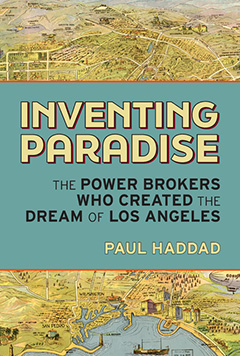L.A. TIMES BESTSELLER
“Historian Haddad (Freewaytopia) offers a meticulous group biography of six powerful men who were behind the supercharged growth of Los Angeles at the turn of the 20th century. Though Haddad describes these men as a ‘Gilded Age-reared oligarchy’ and ‘voracious capitalists,’ his aim is to add depth to one-dimensional negative depictions of them by highlighting the monumental nature of their ambitions. . . . L.A. history buffs will find much to engage them here.”
—Publishers Weekly
“The author’s writing is colorful and lively, as befits this story of a special frontier place and its incredible creators. . . . Inventing Paradise is also very much a story of the dark side of Los Angeles’ colorful past. That history includes chicanery, falsehoods, outright fraud, and racism. . . . Haddad intends to bring ‘order out of chaos’ in explaining the history of LA through the golden age of its rise and its often unscrupulous founders. The book is well organized, unlike the city of Los Angeles itself! Inventing Paradise is annotated, has a bibliography, illustrations, and a list of annexations and consolidations.”
—New York Journal of Books
“Paul Haddad’s Inventing Paradise is an enthralling, deeply researched account of the leaders of industry who built a small, agrarian riverside village into one of America’s largest, strangest, most alluring cities. This is a story of speculation, trickery, and greed as well as earnest, almost realized visions of a true and accessible Utopia. The research is astounding, the writing propulsive, heartfelt, and even funny. Like the best histories, this work is about who and where we are, not only recounting the past but also illuminating the future.”
—Jeff Hobbs, author, The Short and Tragic Life of Robert Peace (L.A. Times Book Prize winner)
“Paul Haddad has written a delightful and immersive account of the formative years of a great American city. With a novelist’s sense of voice and detail and a historian’s command of the national context, Haddad reminds us that no element of contemporary Los Angeles was pre-ordained—and invites us to reflect on the ways that the past shapes the places we call home.”
—Henry Grabar, author, Paved Paradise: How Parking Explains the World
“Inventing Paradise interweaves the lives of the city builders who are remembered in the names of Los Angeles’s streets and neighborhoods—Chandler, Huntington, Sherman, Mulholland, and more—to reveal how and why L.A. grew into today’s wacky sprawl of neighborhoods, canyons, and beachfront. Paul Haddad’s captivating account describes how the city’s boundaries, never planned out but assembled piece by piece over decades, formed from the hubris and greed of these men, who found their sun-warmed paradise between the mountains and the Pacific and grew audacious dreams into fortunes.”
—Kevin Roderick, editor and publisher, L.A. Observed
“There are sub-themes here of race, class, and geography that help flesh out the story, told with admirable research. . . . If you’d really like to know how “LA Etc.” went from Wild West to what it is today, this is the book for you.”
—Orange County Tribune
“Paul Haddad’s Inventing Paradise is a brilliant and entertaining look at the early history and development of Los Angeles, told via the lives of six towering figures who turned a dry, small town into a verdant, thriving, metropolitan paradise. It is destined to join such outstanding works as Mike Davis’s City of Quartz and Gary Krist’s The Mirage Factory as classics of L.A. history.”
—Steve Soboroff, Los Angeles-based businessman, philanthropist, and civic leader
“In the tradition of Carey McWilliams, Kevin Starr, and D.J. Waldie, Haddad unveils with deep research and critical flair six historical power brokers who turned Los Angeles into a profitable (for some) urban paradise. By hoarding resources and controlling public information, these six men helped shape the city we love and struggle with today. A must-read for L.A. history buffs and urbanists alike!”
—Pamela Prickett, author, The Unclaimed: Abandonment and Hope in the City of Angels
“Compelling from start to finish, Haddad traces the seemingly impossible development of the Shangri-La of the Southland through the exploits of six titans that built Los Angeles. His rigorous research uncovers anecdotes, documents, and conversations that breathe life into each paragraph. Inventing Paradise is a brilliant read, and a must-own historical tome for anybody with even a passing interest in Los Angeles!”
—Evan Lovett, L.A. in a Minute
“Paul Haddad does a fantastic job of telling the story of how Los Angeles went from a city with the largest rail system in the world to car-dominated, smog filled sprawl. Despite the last 80 years of car-centric planning, I’m optimistic that Angelenos have had enough of living with the consequences of building a city that forces them to drive for nearly all trips. Haddad’s expert account of how we got here is a gripping tale of past mistakes, and also of future possibilities to create a better city.”
—Michael Schneider, founder of Streets For All
“Sure, everyone knows how amazing L.A. is now . . . but do you know how we got to be this miraculous metropolis? Inventing Paradise is a fascinating and engaging exploration of the City of Angels, revealing just who made the city and how their motivations led to an imperfect paradise.”
—Alex Cohen, Emmy award-winning journalist








